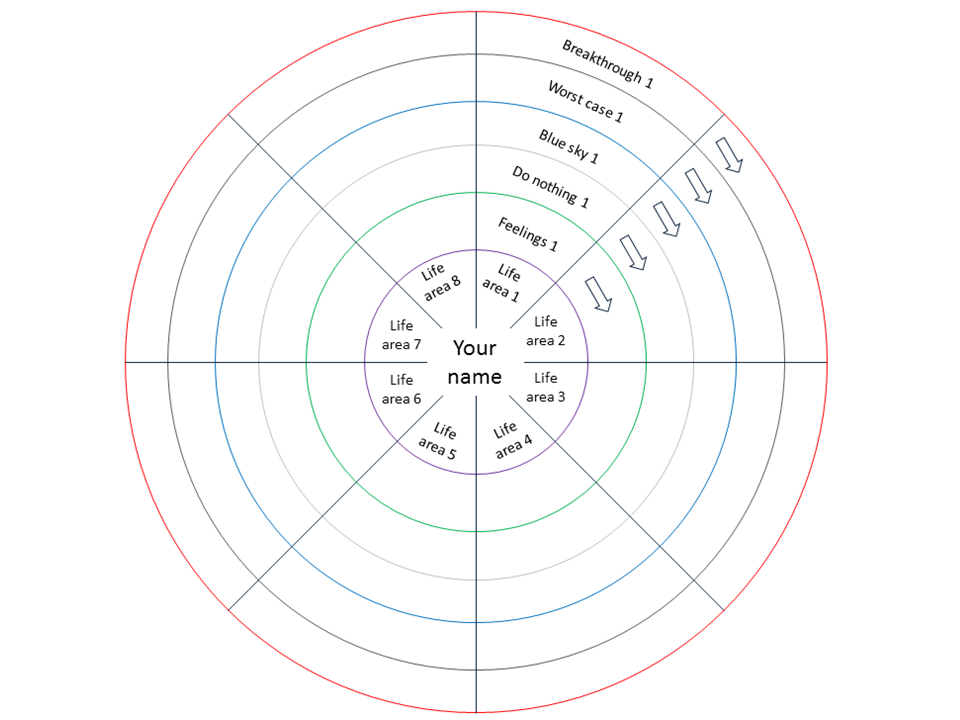"Future mapping" takes a holistic view of what you want for yourself and others. It includes a review of where you are now and where you would like to be.
You will find three simpler (but not as comprehensive) techniques - "Active imagination", "Perfect days" and "The Dice Man" in the Related Exercises list at the bottom of the page.
For all the exercises you will need to think of a time in the future you want to focus on for your new future. So pick a timeframe that feels right for you.
If you decide you want to make some changes to your life it's important to turn your vision of the future into a short list of actions that will set you on the right path.
At the end of the exercise write down the most important actions you need to take within the next week to kick-start your new future!
The exercise
This technique helps you review your current circumstances, and set you on a new path. Its great strength is that, because of the way the process works, it gives you a rounded, balanced view of your life and enables you easily to check out whether your current priorities are the right ones. It points you in new directions that will help you to reach your goals.
You can use it to review your life as a whole, or a part of it such as your career or your work priorities. In fact in a more detailed version it is also used by businesses as a business development planning process.
Step 1: Your focus and timeframe
The first thing to do is to decide which aspect of your life you want to focus on. For our example we will assume that you want to do an overall review. You also need to decide on a time frame that you want to use in thinking about your future. Something like eighteen months is often about right – it enables you to think of things in your life potentially being quite different from the present, but is near enough that you will have to start making changes now to deliver the future you want. In other words it will prompt you to action. We will assume eighteen months in our example.
Step 2: What is important to you?
Now write a list of aspects of your life that are really important to you, or that may become important to you over the next eighteen months. This list could contain
- people – partners, children, family, friends
- activities – fitness, hobbies, holidays
- places – home, work
- themes – spirituality, creativity, wellbeing
- practicalities – finances, skills
and whatever else is right for you.
You may have four or five areas or you may have a dozen or more – it doesn’t really matter, it just takes longer the more areas you have. You may find as you go through the process that you jettison some and think of some new ones. I have shown eight areas in the chart below.
Step 3: Draw the future-map outline
Now draw yourself a diagram like the one below, putting your name at the centre and each of your chosen life areas around the inner circle.

Step 4: Ask yourself the following questions
Now ask yourself some simple questions about each of your life areas. Go round each of your life areas asking the same question about it before moving on to the next question. When you have completed answering the first question go on to the second, again asking it about each of your life areas.
The questions are:
- FEELINGS: How do I feel about this area right now? Jot down some words on your chart.
- DO NOTHING SCENARIO: What happens if I do nothing different over the next eighteen months. What will happen in this area?
- BLUE SKY: How would I really like this area to be in eighteen months. What will be happening? What will it look like if everything goes fabulously well?
- WORST CASE SCENARIO: What about if everything goes disastrously wrong? Use the answers here to plan for possible contingencies.
- BREAKTHROUGH: And now, because we often don’t dream as fabulously as we might, repeat Q3, but imagine a couple of real lucky breaks have happened to you. Think really differently – the breakthroughs you want to happen have happened.
Step 5: Reflect, prioritise, set immediate actions
Finally take some time to reflect and sum up your goals for the future. Write down a set of actions and deadlines to deliver your goals, making sure that you have at least two actions that need to be completed by the end of next week.
